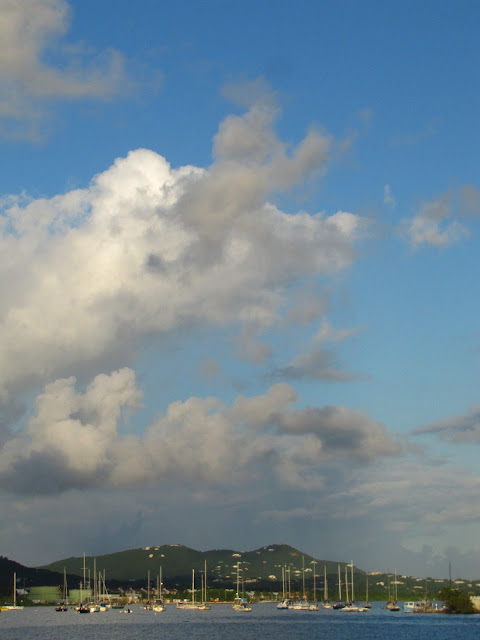The Caribbean in winter is, shall we say, a touch on the muggy side and destinations around 17d lat tend to be a bit humid, sunny and...
buggy. Though we Latinos are a tropical people, after living in a seasonal environment for 28 years, this 1/2 Latina lost the ability to sweat pretty. You can imagine what transpired (or perspired in this case) on a ship with 34 souls in the middle of the Caribbean Sea without air conditioning and shower limitations to every THREE days. I bet those downwind could smell us a nautical mile away.
 |
| This is what I left: Winter in Woods Hole |
 |
| and arrived in: Winter in the Caribbean. Samana, DR |
I spent my first day on the Cramer learning about the ship from her sails and lines to cleaning almost every imaginable surface, for the most part, under the intense sun and boiling humidity. Though I experienced intense sweating incontinence, I remained cheerily positive and eager to learn about the things that would keep me alive as we traversed the Caribbean Sea.
 |
| Cramer under full sail. Photo credit: SEA |
Part of the experience involved sail handling, so I busied myself with learning her major sails:
4 lower, Marconi rigged: Forestaysail (stay'sl), Main Staysail (main'sl), Main Sail (the main)
Headsails, tri-sails (tri'sl): Jib, Jib Top Sail (JT), Raffee
Square Sails (square'sl): Course and Top Sail (top'sl)
Fisherman's staysail, trapezoidal in shape: Fisherman or Fish
 |
| Students creating a balatine coil for the JT halyard. You can see the main (sail) in the background. |
I also had to learn zillions of lines in order to set, strike, jib (or gybe), heave-to, tack and furl.
Halyard (to pull the sail up)
Downhaul (to pull the sail down)
Sheets and travelers (port & starboard), to move the sails to either port or starboard
In-Hauls and Out-Hauls, pull the clew of the squares'ls
Brails: haul in the corners of the tops'l and course
Preventer (for the main): to prevent violent beam movement
Jiggers: to trim sails
Braces (for the square'sls): for trim and course direction
There are more lines, but you get the picture. For example, the marconi sails each have 1 halyard, 1 downhaul, two sheets and one jigger, unless it's the Main which, in addition to the listed lines, has a preventer and two other lines, of which I forget. Some sail even have TWO halyards! There are a lot of lines to learn and it can be overwhelming at first...especially on a moonless night in the middle of a squall.
Equally important to learn: there are also a million ways to coil line.
 |
| If I remember correctly, these are the Tops'l in-hauls and out-hauls. |
I learned to 'sweat' lines, which, initially, I thought was ship humor because it was so freaking hot and we were ALL PROFUSELY SWEATING. Imagine my embarrassment when the call to 'sweat a line' was given and I rubbed my sweaty hands on it grinning like the idiot. Never a dull moment with me; loads of entertainment for the crew.
 |
| part of the HEAVE team for the fish throat halyard |
To 'sweat a line' means pull, with as many people as you can and as hard as you can, to get a sail up as far as it will go. This involves pushing the line forward then backward and down as hard as you can. One other person takes up the slack by pulling the line horizontally from its pin. This process is repeated numerous times (if it makes your hands bleed, you're doing it right) before making fast the line (lopping it around its pin).
 |
| Sweating the fisherman throat halyard. Notice the number of hands on the line. |
Actually, sweating is pretty fun, because you get to yell "TWO....SIX...HEAVE!" as loud and as you can. "TWO" is yelled as you push the line forward, followed by "SIX" as you pull down (and I mean your entire body nearly hits the deck). "HEAVE" is then yelled by your line counterpart as they take up slack as you help guide the line toward the pin. It's all very fun, trust me! Thanks to 14 years of competitive swimming, I am an excellent line-sweater.
 |
| The Main, un-reefed. It takes a lot of sweaty students to haul her lines. |
It took 48 hours and 6 watch-standings for my hands to callus and strengthen, and another 48 hours before my forearms were as strong as steel. Intimidating at first and sometimes frustrating, the myriad of lines and sails and knots and coil knowledge became routine and led to really, really fun things. I'm convinced that, as long as there's enough deodorant, anything is possible!
Next up: Watch routine and life aboard the Cramer.
























































